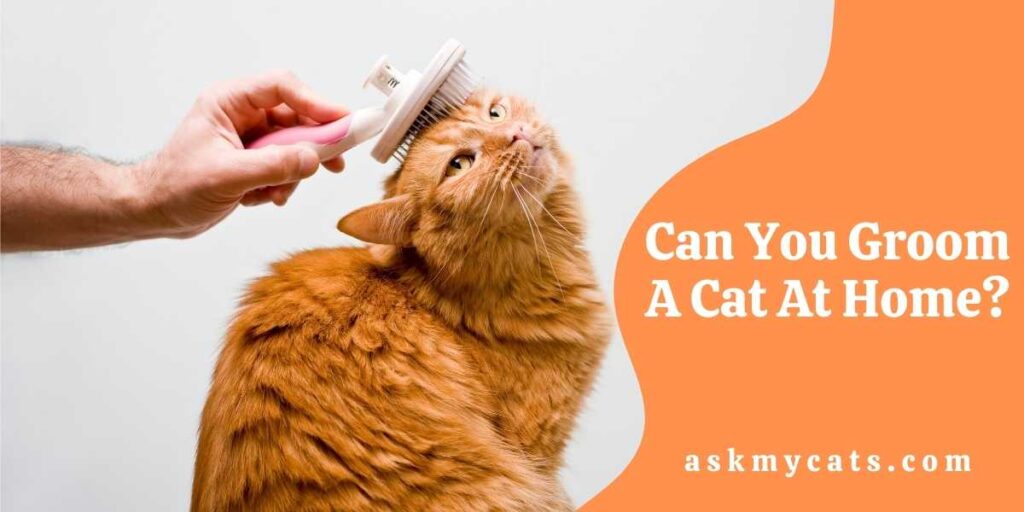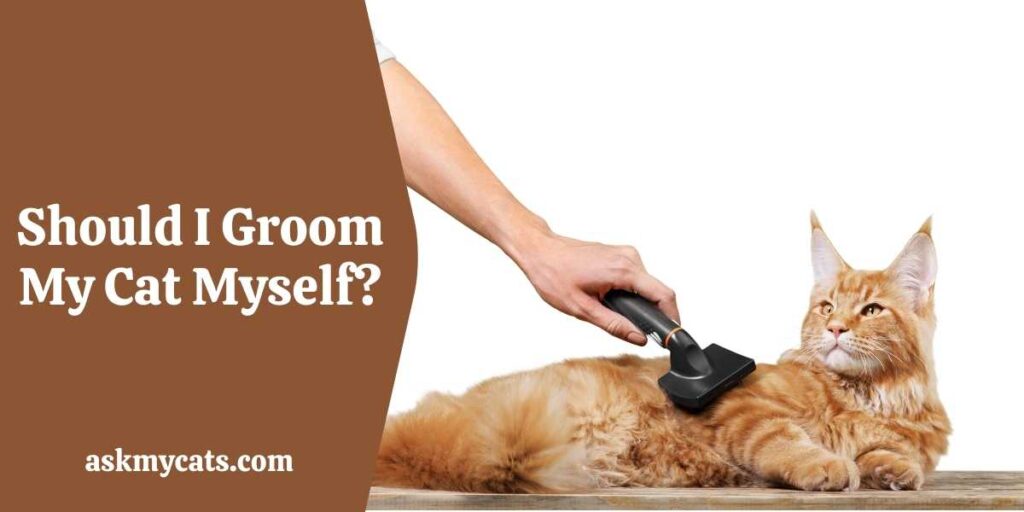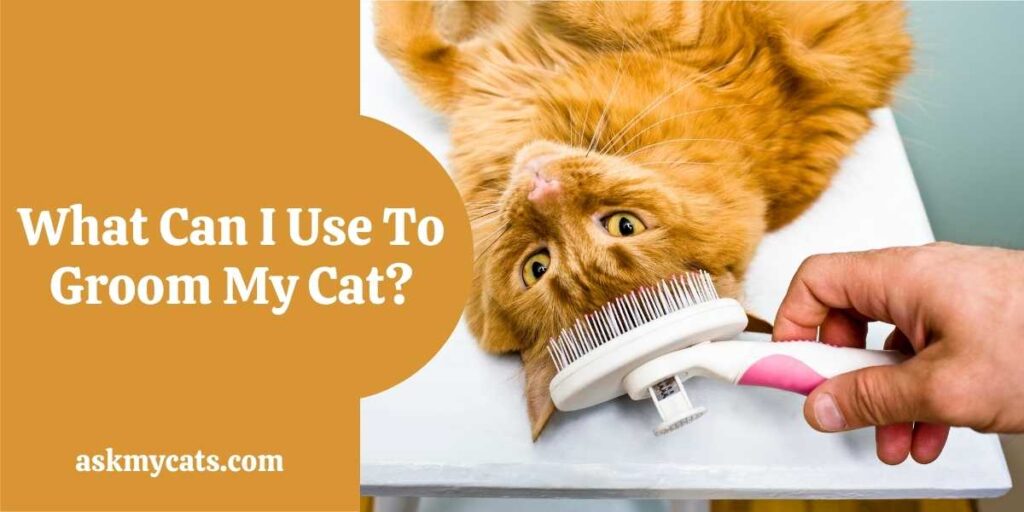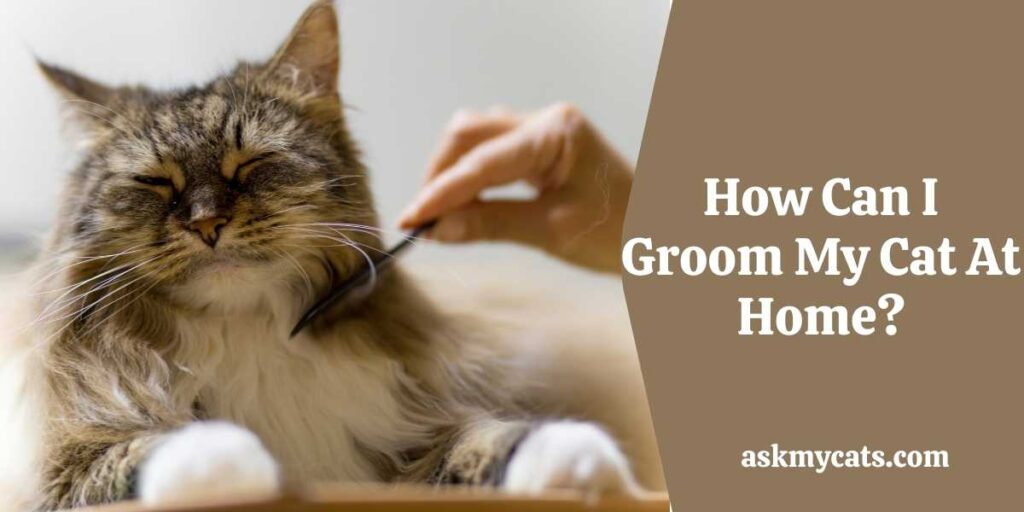Most cats are extremely self-conscious about their looks and spend over half of their waking hours grooming themselves to perfection.
Cats are independent creatures who like to take care of themselves, but that doesn’t mean you shouldn’t assist them in their grooming regimen.
Yes, even at home, you can groom your cat. However, there are several advantages to keeping your cat’s skin and hair in good shape. It makes them feel terrific and aids with their overall wellness.
Your cat may not enjoy the grooming procedure, but these tips will help you have a more tranquil and efficient grooming session.


Give Your Cat the Perfect Day
Get the Free Ebook!
Should I Groom My Cat Myself?
Yes, you can groom your cat on your own.

You’re ready to start brushing your cat after having the right grooming supplies. In an ideal world, your cat will appreciate being caressed and will not resist, but just in case, move gently and carefully.
Before brushing, examine for any tangles or knots and disentangle them using a comb. For matted hair, use a de-matting comb to gently detangle the matted hair from the tips toward the skin with a de-matting comb.
Using the brush or your thumb and index finger, untangle little sections at a time. When cutting matted hair, never use scissors. A grooming specialist should groom cats with extremely matted fur, especially if shaving is required.
After you’ve gotten rid of any knots, make sure your cat is relaxed and begin massaging by hand before gradually introducing the brush. All cats are interested, and they will want to inspect and sniff the brush to become acquainted with it.
Brush in the direction the coat develops, starting at the neck and working your way down to the tail. Be wary of knots or tangles to disentangle hair and use an appropriate comb. Guide the brush with your hand and check for bumps or injuries.
Grooming is how cats socialise, making it a fun bonding experience for you and your cat.
Always keep an eye out for symptoms of tension or pain in your cat, and if they resist, stop brushing right away and try again later.
Most cats dislike baths, and they are not hesitant about expressing their displeasure. However, with patience, you can wash your cat safely and properly. On the other hand, most short-haired indoor cats will not require bathing.
Outdoor cats, on the other hand, or cats that get themselves into a mess will need to be washed. You should always use suitable shampoo and consider any allergies or skin concerns you may have.
Never use human shampoo on your cat since it is too abrasive for their skin. To keep your ears dry, gently insert a cotton ball in each one.
Place a rubber mat in the sink or tub and fill it with a couple of inches of warm water whenever you’re ready. Wet your cat completely and apply shampoo and lather, starting at the head and working your way down to the tail.
Rinse and wipe their face with a washcloth, but avoid their eyes and ears. Suppose your cat can accept it, dry with a towel or a hairdryer set to the lowest heat setting. Most key, praise your cat frequently throughout the wash to comfort him.
What Can I Use To Groom My Cat?
You need a metal comb, rubber brush and a trimmer to groom your cat.

Grooming your cat should begin at a young age to become a natural part of their routine. Curious kitties sometimes get themselves into sticky situations, so you may have to assist your little one in cleaning up!
Cats can get stiff as they age, making it difficult to clean certain areas. As a result, frequent cat grooming should be a part of your daily care regimen for the rest of your cat’s life.
Grooming a cat from a young age helps you form a deep relationship with them via physical contact and establish a shared sense of trust.
Shorthaired cats can groom themselves, so a quick brush once a week should suffice to spend time with them while keeping their coat; however, longhaired cats will benefit from a daily brush to minimise matting, knots, and excessive fur ball build-up.
Matting can be a highly unpleasant and even painful experience for cats, so your assistance will be greatly appreciated – even if they don’t express it at the time!
How Can I Groom My Cat At Home?
You can regularly brush your cat’s fur and trim using clippers at home.

Once a week, remove knots or tangles using a fine-toothed metal comb for shorthaired cats. Remove any loose hairs using a natural bristle or rubber kitty brush.
Brush or comb your cat’s hair gently in the direction their hair grows, using strokes in the direction that their hair grows.
Sweep the coat up in the direction of the head with the bristly cat brush, then smooth it down again.
Brush your longhaired cat with a steel comb once a day.
If required, any knots may be coaxed out with your fingertips using a moist towel. Never use scissors on your cat since there’s a chance they’ll shift and get a terrible nick in their skin. If there’s a very terrible knot or several knots, consult your veterinarian for any help.
If you’re having trouble grooming your cat, try giving him food rewards, soft strokes, and calming words. Begin grooming your cat as soon as they are soothed and occupied by their reward and extra attention.
Take advantage of the chance to inspect your cat’s teeth, eyes, ears, and gums while they’re being groomed, but if your cat becomes stressed out while grooming, it’s time to take a break.
Some cats, especially outdoor cats and those that like their scratching post, take care of their claws via normal wear and use, but if your cat spends a lot of time indoors or is senior, they may require assistance.
Weekly inspections and occasional claw clipping prevent their claws from expanding inwards into their pads, which can cause pain and infection (much like an ingrowing toenail).
Overgrown claws in older cats can indicate osteoarthritis, so see your veterinarian if any extra treatment is required.
How Do You Sedate A Cat For Grooming At Home?
You can use over-the-counter sedatives to sedate your cat before the grooming process successfully.
However, before using this form of sedative, you should consult with your veterinarian. Ask your veterinarian how long you should administer the medicine before the grooming process.
Discuss your alternatives and sedative preferences with your veterinarian, or better yet, ask him for his best advice.
The use of general anaesthesia to sedate a cat for grooming is sometimes the best choice, but only in severe instances, such as when the cat’s hair is excessively matted or when the animal has parasites or infected lacerations or injuries.
A licensed veterinarian can administer general anaesthesia through gas inhalation, injection, or a combination of these two methods.
Washing your cat regularly helps avoid ticks and fleas, and if these parasites do appear, they may be readily handled with frequent baths, flea removers, and sprays.
Regular grooming, which includes bathing and brushing, will allow you to inspect your pet cat for odd lumps and skin blemishes. If you see any odd lumps on your pet cat’s body, contact your veterinarian straight once to get your pet checked.
Frequently Asked Questions
What can I use to wash my cat if I don’t have cat shampoo?
Instead of cat shampoo, you may use foam, cat bath wipes, washcloths, water and vinegar, soap, Johnson’s baby shampoo, and Dawn dishwashing liquid detergent to wash your cat. Any human or neutral goods should be avoided since they may be hazardous to your cat or contain dangerous substances.
Can I use Dawn dish soap to wash my cat?
As long as your pet doesn’t have a skin illness or other problem, Dawn is typically safe to apply on their skin. In certain cases, dish soap might aggravate the inflammation.
Can we use human soap for cats?
Human shampoo should never be used on cats since it is unsuited for cat hair and might dry up their skin. Use a cleaning and deodorizing shampoo developed with natural components in a water bath.
Final Words
Grooming a cat at home can be very easy. Brush her coat in the direction it grows, working along with the lay of her fur. Brush all over her body, including her chest and abdomen, removing dead hair and knots one region at a time. A rubber brush can be very useful for removing dead hair on cats with short fur.
Ask your questions in the comments section below.
